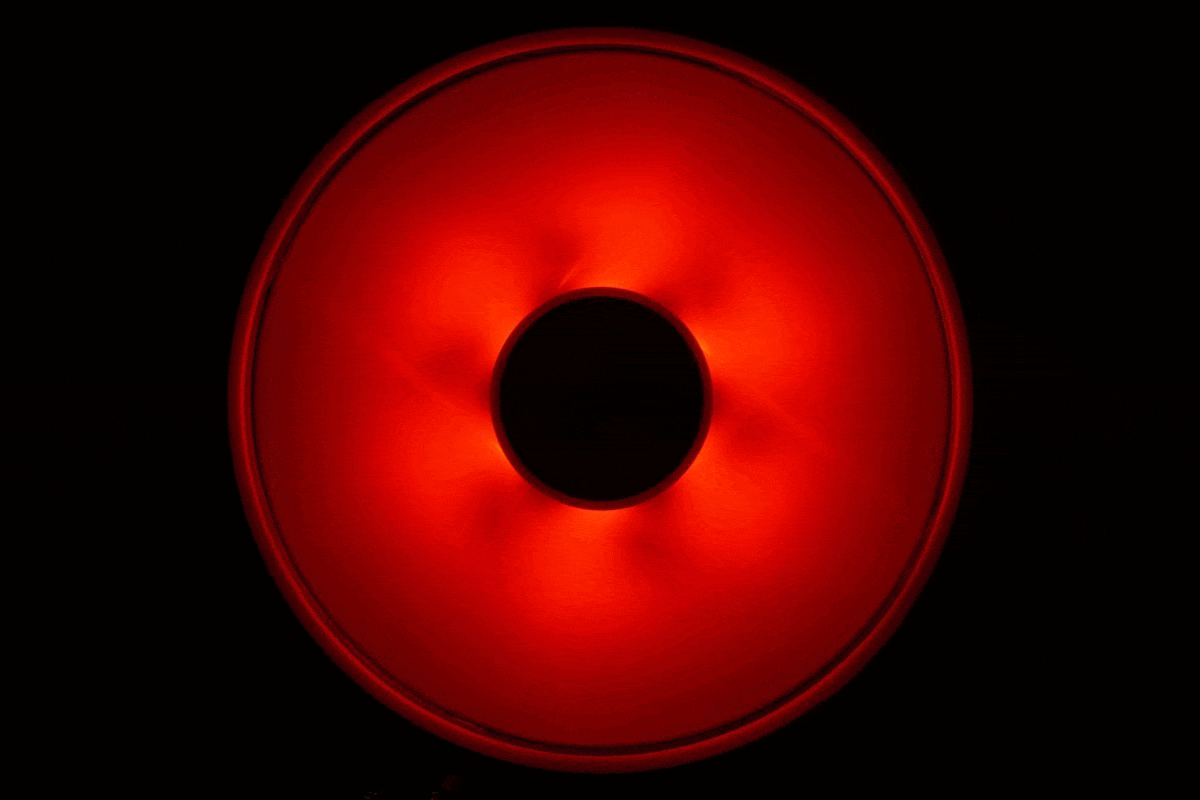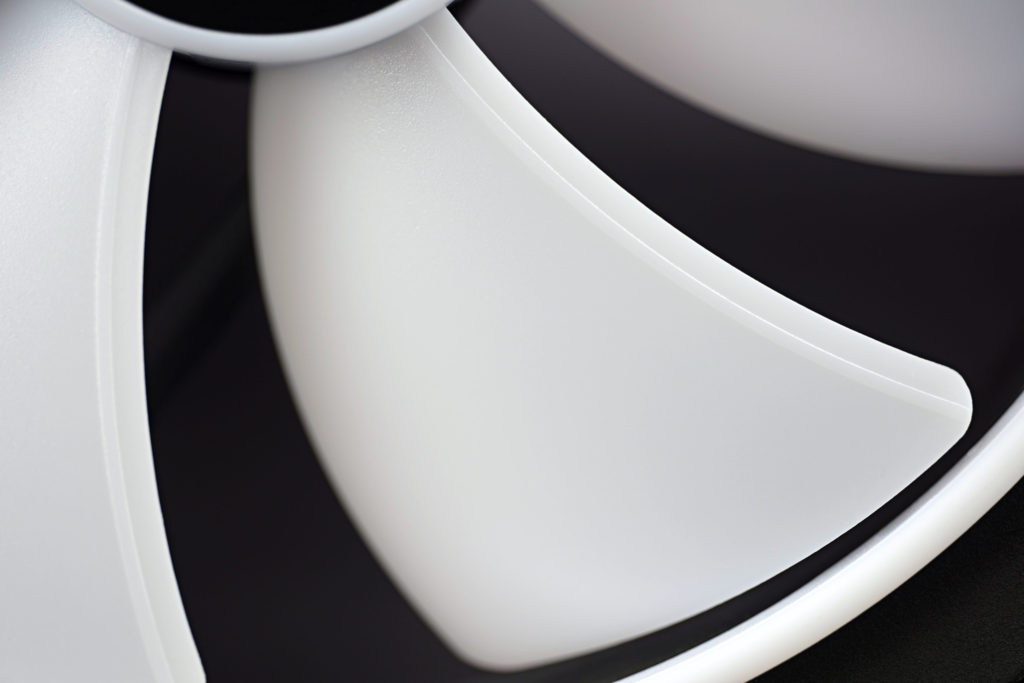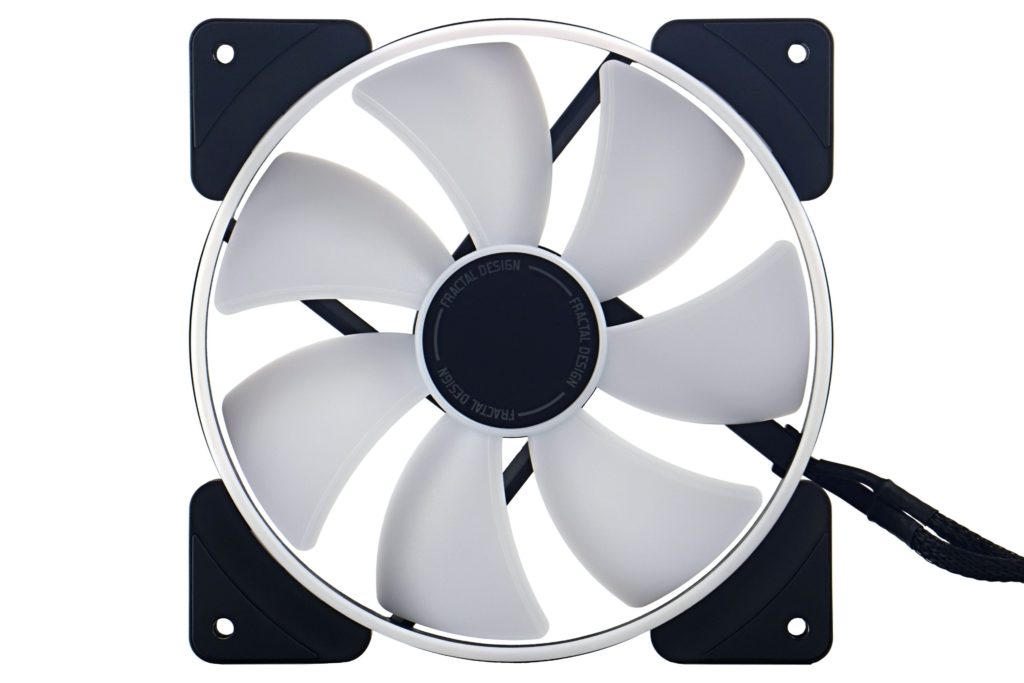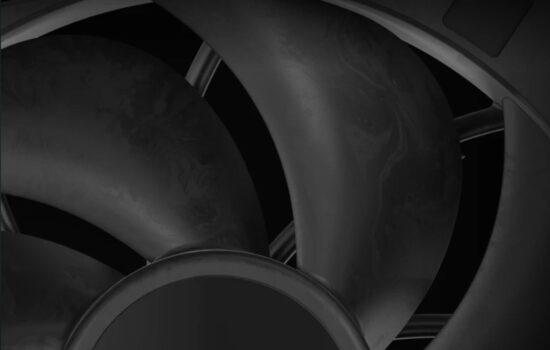Fractal Design Prisma AL-14 PWM in detail
Fractal Design claims the Prisma models as its most efficient 140mm fans. According to the specs, they are supposed to achieve the highest airflow at a lower noise level than the Aspect 14s. However, this is physically impossible due to the constructional differences of the two fans. The title of the article has a bit of a pejorative tone and while the Prisma AL-14 PWM is a decent fan, it already has a superior from its own ranks.
With the Prisma fans, Fractal Design jumped into the “RGB LED” waters that it hadn’t swam in before (until their release). The company didn’t bother with the analog generation on 12V and started right away with lighting powered digitally by 5V via a 3-pin connector. The Prisma AL-14 PWM fan, which will be the subject of the following analysis, was thus (together with the SL-14/12 and AL-12 models) among the first Fractal Design products with (A)RGB LEDs.
In the following, the Prisma AL-14 PWM model under test will often be confronted with the Aspect AL-14 PWM fan. We’ve already tested that one, although it came out more than two years later. In that time, Fractal Design has managed to change the way they design fans, which we’ll discuss in the text.
One of the things that hasn’t changed across the model lines (Prisma and Aspect) is the rotor design. It is identical. Not just in shape, but in the material used and its thickness. Thus, the rotor consists of seven wider but thinner blades with less curvature. Behind the leading edge of each blade is a full-length protrusion, which is designed to break up unwanted microturbulence at the fan intake. This detail is also the same on the newer Aspect AL-14 PWM fans. Nevertheless, the specifications of the Prisma AL-14 PWM fans claim up to 33.1% higher airflow at the same speed (1700 rpm).
The static pressure is supposed to be 23.3% higher compared to these fans, which is also a bit “off”, but here we can already look for reasons why the Prisma AL-14 PWM fan should be potentially better in this respect. This is mainly due to the significantly more powerful motor (compared to the Aspect AL-14 PWM), which can maintain a higher rotor speed in a high resistance environment. And also because of the smaller gap between the frame and the tips of the blades. So while the blades are the same length on both fans, they have a tighter margin on the Prisma AL-14 PWM fan. However, the overall frame diameter is only 0.5mm narrower, which makes for a negligible area in terms of overall cross-sectional area for where air can leak inefficiently.
The Prisma AL-14 PWM frame also differs from the Aspect AL-14 PWM frame in that it is two-piece. Its front part is white/light guiding (to highlight the ARGB LEDs) and the back part is black. The mutual contact of these parts is through a groove that makes the fan tunnel tight enough so you don’t have to worry about static pressure drop, and the transition between these parts is fairly smooth and everything lines up nicely all around. Still, with the Aspect AL-14 PWM fans Fractal Design didn’t complicate things so much and made the frame/tunnel out of one piece.
In addition, all Prisma fans have rubber pads to dampen vibration as opposed to the Aspect fans. This makes the Prisma AL-14 PWM one of the few fans that do not transmit any vibration to the frame even at higher speeds.
The fan cables are long, 50–70 cm. The shorter measure belongs to the 4-pin connector (PWM) for the motor power supply, the longer to the 3-pin ARGB. There are two connectors for lighting. In addition, for the actual lighting, there is one more for connecting another fan. This comes in handy with limited number of ARGB connectors (especially on the motherboard, hubs usually have plenty of them). And it’s also practical in terms of more elegant cable management.
| Brand and model of fan | Paper specicifations * | Price [EUR] | ||||||||
| Format (and thickness) in mm | Connecting | Speed [rpm] | Airflow [m3/h] | Static pressure [mm H2O] | Noise level [dBA] | Bearings | MTBF [h] | |||
| Motor | RGB LED | |||||||||
| Fractal Design Prisma AL-14 PWM | 140 (25) | 4-pin (PWM) | 3-pin (5 V) | 500–1700 | 176.44 | 2.38 | 34.1 | sleeve | 100 000 | 21 |
| Gigabyte Aorus 140 ARGB | 140 (25) | 4-pin (PWM) | 3-pin (5 V) | 800–1700 | 51.48–103.03 | 0.59–2.18 | 8.9–35.8 | sleeve | 73 500 | 28 |
| BeQuiet! Light Wings (BL075) | 140 (25) | 4-pin (PWM) | 3-pin (5 V) | 2200 | 121.82 | 2.30 | 31.0 | rifle | 60 000 | 29 |
| Fractal Design Aspect 14 RGB PWM | 140 (25) | 4-pin (PWM) | 3-pin (5 V) | 500–1700 | 33.98–132.52 | 0.09–1.93 | 10.0–35.5 | rifle | 90 000 | 18 |
| DeepCool FK120 | 120 (25) | 4-pin (PWM) | N/A | 500–1850 | 117.21 | 2.19 | 28.0 | fluid | N/A | 11 |
| Asus TUF Gaming TF120 | 120 (25) | 4-pin (PWM) | 3-pin (5 V) | 1900 | 129.12 | 2.50 | 29.0 | fluid | 250 000 | 14 |
| BeQuiet! Light Wings (BL072) | 120 (25) | 4-pin (PWM) | 3-pin (5 V) | 1700 | 70.53 | 1.66 | 20.6 | rifle | 60 000 | 26 |
| DeepCool FC120 | 120 (25) | 6-pin (PWM) | 6-pin (5 V) | 500–1800 | 105.19 | 1.83 | 28.0 | hydrodynamic | N/A | 20 |
| Nidec Servo Gentle Typhoon D1225C (2150/12) | 120 (25) | 4-pin (PWM) | N/A | 2150 | 117.23 | 2.87 | 30.0 | ball | 100 000 | 20 |
| BeQuiet! Shadow Wings 2 (BL085) | 120 (25) | 4-pin (PWM) | N/A | 1100 | 65.41 | 0.82 | 15.9 | rifle | 80 000 | 15 |
| Noctua NF-A12x25 PWM | 120 (25) | 4-pin (PWM) | N/A | 450–2000 | 102.10 | 2.34 | 22.6 | SSO2 | 150 000 | 28 |
| Corsair AF120 Elite (black) | 120 (25) | 4-pin (PWM) | N/A | 400–1850 | 18.52–100.41 | 0.09–1.93 | 31.5 | fluid | N/A | 24 |
| Cooler Master MasterFan SF120M | 120 (25) | 4-pin (PWM) | N/A | 650–2000 | 105.33 | 2.40 | 5.5–22.0 | ball | 280 000 | 33 |
| Akasa Alucia SC12 | 120 (25) | 4-pin (PWM) | N/A | 500–2000 | 95.65 | 1.94 | 33.1 | hydrodynamic | N/A | 12 |
| BeQuiet! Silent Wings Pro 4 (BL098) | 120 (25) | 4-pin (PWM) | N/A | 3000 | 142.50 | 5.31 | 36.9 | fluid | 300 000 | 32 |
| Thermalright X-Silent 120 | 120 (25) | 3-pin (DC) | N/A | 1000 | 61.31 | N/A | 19.6 | fluid | 50 000 | 5 |
| Fractal Design Aspect 12 RGB PWM | 120 (25) | 4-pin (PWM) | 3-pin (5 V) | 500–2000 | 22.09–95.14 | 0.23–2.34 | 10.0–33.2 | rifle | 90 000 | 16 |
| BeQuiet! Silent Wings 3 (BL066) | 120 (25) | 4-pin (PWM) | N/A | 1450 | 85.80 | 1.79 | 16.4 | fluid | 300 000 | 21 |
| Gelid Zodiac | 120 (25) | 4-pin (PWM) | 3-pin (5 V) | 700–1600 | 111.29 | 1.47 | 35.0 | hydrodynamic | N/A | 10 |
| Fractal Design Dynamic X2 GP-12 PWM | 120 (25) | 4-pin (PWM) | N/A | 500–2000 | 148.83 | 0.51–2.30 | 10.0–32.2 | rifle | 100 000 | 12 |
| BeQuiet! Pure Wings 2 (BL039) | 120 (25) | 4-pin (PWM) | N/A | 1500 | 87.00 | 1.25 | 19.2 | rifle | 80 000 | 11 |
| Gigabyte Aorus 120 ARGB | 120 (25) | 4-pin (PWM) | 3-pin (5 V) | 800–1700 | 31.47–69.40 | 0.37–1.48 | 7.3–28.6 | sleeve | 73 500 | 25 |
| Arctic BioniX P120 A-RGB | 120 (30) | 4-pin (PWM) | 3-pin (5 V) | 400–2300 | 81.55 | 2.10 | 33.4 | fluid | N/A | 21 |
| Akasa OTTO SF12 | 120 (25) | 4-pin (PWM) | N/A | 0–2000 | 164.84 | 3.59 | 7.1–31.7 | ball | 80 000 | 22 |
| Cooler Master SickleFlow 120 ARGB | 120 (25) | 4-pin (PWM) | 3-pin (5 V) | 680–1800 | 105.34 | 2.50 | 8.0–27.0 | rifle | 160 000 | 15 |
| Alphacool SL-15 PWM | 120 (15) | 4-pin (PWM) | N/A | 600–1800 | 71.40 | 1.20 | 32.0 | ball | 50 000 | 11 |
| Arctic BioniX F120 | 120 (25) | 4-pin (PWM) | N/A | 200–1800 | 117.00 | 2.10 | 20.0 | fluid | N/A | 10 |
| SilverStone SST-AP123 | 120 (25) | 3-pin (DC) | N/A | 1500 | 96.84 | 1.46 | 23.8 | fluid | 50 000 | 25 |
| Noctua NF-P12 redux-1700 PWM | 120 (25) | 4-pin (PWM) | N/A | 400–1700 | 120.20 | 2.83 | 25.1 | SSO | 150 000 | 13 |
| SilentiumPC Fluctus 120 PWM | 120 (25) | 4-pin (PWM) | N/A | 300–1800 | N/A | N/A | N/A | fluid | 100 000 | 12 |
| MSI MEG Silent Gale P12 | 120 (25) | 4-pin (PWM) | N/A | 0–2000 | 95.48 | 2.21 | 22.7 | hydrodynamic | 50 000 | 31 |
| Asus ROG Strix XF120 | 120 (25) | 4-pin (PWM) | N/A | 1800 | 106.19 | 3.07 | 22.5 | „MagLev“ | 400 000 | 23 |
| Akasa Vegas X7 | 120 (25) | 4-pin (PWM) | 4-pin (12 V) | 1200 | 71.19 | N/A | 23.2 | fluid | 40 000 | 11 |
| Reeven Coldwing 12 | 120 (25) | 4-pin (PWM) | N/A | 300–1500 | 37.54–112.64 | 0.17–1.65 | 6.5–30.4 | sleeve | 30 000 | 12 |
| Reeven Kiran | 120 (25) | 4-pin (PWM) | shared | 400–1500 | 110.10 | 2.95 | 33.6 | fluid | 120 000 | 17 |
| SilentiumPC Sigma Pro 120 PWM | 120 (25) | 4-pin (PWM) | N/A | 500–1600 | 79.00 | N/A | 15.0 | hydraulic | 50 000 | 7 |
| SilentiumPC Sigma Pro Corona RGB 120 | 120 (25) | 4-pin (PWM) | 4-pin (12 V) | 1500 | 56.58 | N/A | N/A | hydraulic | 50 000 | 12 |
| SilverStone SST-AP121 | 120 (25) | 3-pin (DC) | N/A | 1500 | 60.08 | 1.71 | 22.4 | fluid | 50 000 | 18 |
| SilverStone SST-FQ121 | 120 (25) | 7-pin (PWM) | N/A | 1000–1800 | 114.68 | 0.54–1.82 | 16.4–24.0 | fluid | 150 000 | 20 |
| Xigmatek XLF-F1256 | 120 (25) | 3-pin (DC) | N/A | 1500 | 103.64 | N/A | 20.0 | rifle | 50 000 | 16 |
* When reading performance values, a certain amount of tolerance must always be taken into account. For maximum speeds, ±10 % is usually quoted, minimum speeds can vary considerably more from piece to piece, sometimes manufacturers will overlap by as much as ±50 %. This must then also be adequately taken into account for air flow, static pressure and noise levels. If only one value is given in a table entry, this means that it always refers to the situation at maximum speed, which is achieved at 12 V or 100 % PWM intensity. The manufacturer does not disclose the lower limit of the performance specifications in its materials in that case. The price in the last column is always approximate.
- Contents
- Fractal Design Prisma AL-14 PWM in detail
- Basis of the methodology, the wind tunnel
- Mounting and vibration measurement
- Initial warm-up and speed recording
- Base 6 equal noise levels…
- ... and sound color (frequency characteristic)
- Static pressure measurement…
- … and airflow
- Everything changes with obstacles
- How we measure power draw and motor power
- Measuring the intensity (and power draw) of lighting
- Results: Speed
- Results: Airlow w/o obstacles
- Results: Airflow through a nylon filter
- Results: Airflow through a plastic filter
- Results: Airflow through a hexagonal grille
- Results: Airflow through a thinner radiator
- Results: Airflow through a thicker radiator
- Results: Static pressure w/o obstacles
- Results: Static pressure through a nylon filter
- Results: Static pressure through a plastic filter
- Results: Static pressure through a hexagonal grille
- Results: Static pressure through a thinner radiator
- Results: Static pressure through a thicker radiator
- Results: Static pressure, efficiency by orientation
- Reality vs. specifications
- Results: Frequency response of sound w/o obstacles
- Results: Frequency response of sound with a dust filter
- Results: Frequency response of sound with a hexagonal grille
- Results: Frequency response of sound with a radiator
- Results: Vibration, in total (3D vector length)
- Results: Vibration, X-axis
- Results: Vibration, Y-axis
- Results: Vibration, Z-axis
- Results: Power draw (and motor power)
- Results: Cooling performance per watt, airflow
- Results: Cooling performance per watt, static pressure
- Airflow per euro
- Static pressure per euro
- Results: Lighting – LED luminance and power draw
- Results: LED to motor power draw ratio
- Evaluation
















